December 9, 2024 · 12 min read
Streamlining Non-Profit Board Meetings for Greater Impact

Shaimaa Badawi
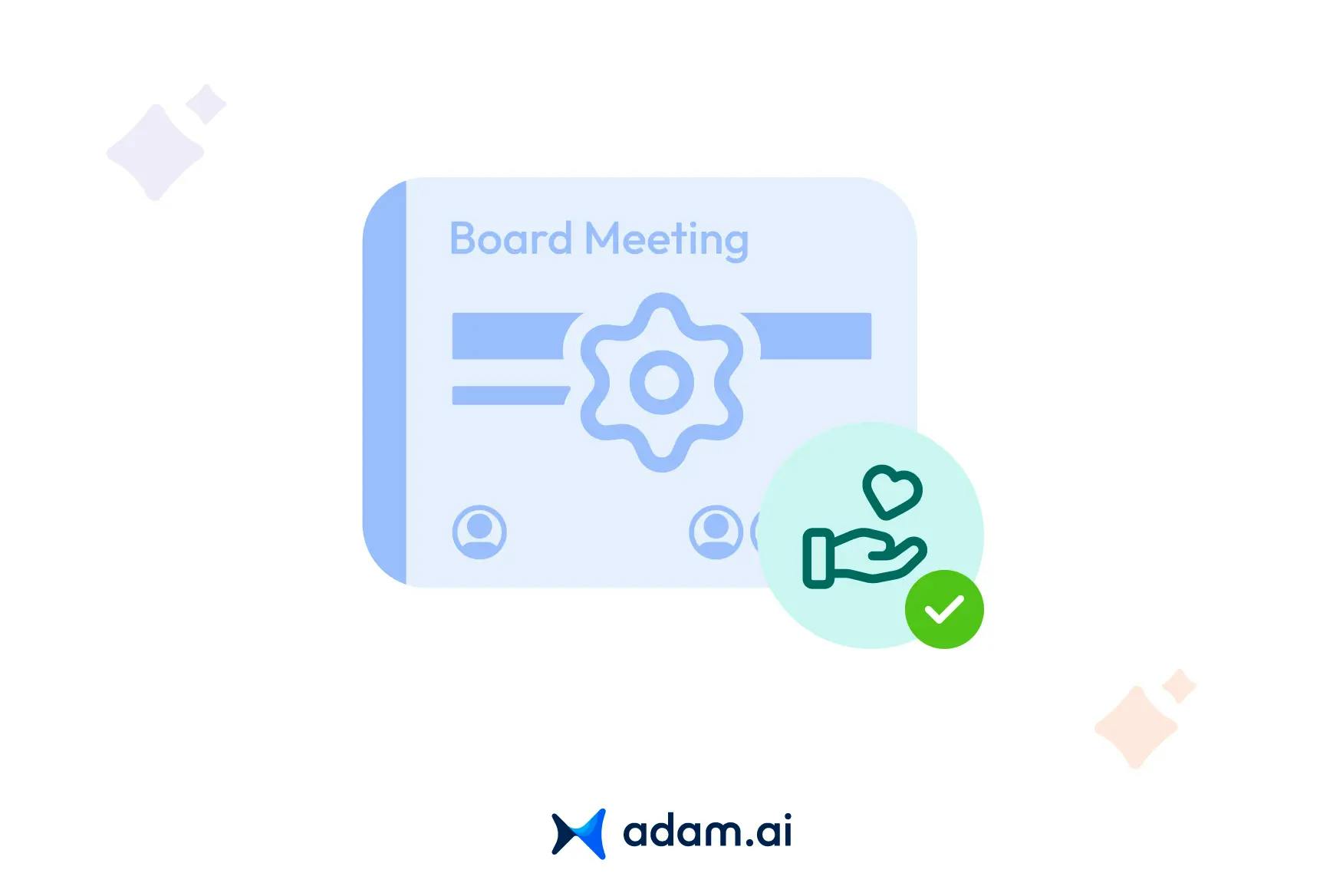
Non-profit board meetings play a pivotal role in driving organizational success, but they often face challenges like poor time management, lack of preparation, and ineffective follow-ups. In this article, we explore strategies to streamline these meetings and insights that can help non-profits optimize their meetings for greater impact.
Why is effective board meeting management essential for non-profits?
Effective board meeting management is crucial for non-profits as it directly impacts their ability to achieve their mission, maintain transparency, and optimize limited resources. Non-profit organizations operate under unique pressures, such as tight budgets and accountability to donors, making well-managed board meetings essential for their success.
Why board meeting management matters
- Strategic decision-making: Board meetings are the cornerstone of strategic planning. Proper management ensures that discussions stay focused on critical issues, such as resource allocation, program effectiveness, and long-term goals.
- Accountability and transparency: Effective meetings provide a platform for reviewing financials, discussing program outcomes, and evaluating compliance. This fosters trust among stakeholders, including donors, volunteers, and the communities served.
- Maximizing time and resources: Poorly managed meetings waste valuable time that could be spent on advancing the organization’s mission. Structured agendas and clear objectives ensure that every minute of the meeting contributes to meaningful outcomes.
- Enhancing collaboration: A well-managed meeting creates an environment where all board members feel heard and can contribute their expertise. This diversity of input strengthens decision-making and builds a cohesive team.
- Driving follow-through: Clear documentation and action tracking during meetings ensure that decisions are implemented and progress is monitored, preventing delays or overlooked tasks.
What challenges do non-profits face in managing board meetings?
Non-profits face several challenges in managing board meetings, ranging from logistical issues to fostering effective collaboration. These challenges can hinder productivity, reduce engagement, and impact the organization’s ability to make strategic decisions.
Challenges non-profits face in managing board meetings
- Lack of clear agendas
Many non-profits struggle to create comprehensive and focused agendas. Without a clear roadmap, meetings often veer off-topic, leaving important issues unresolved. - Time management issues
Meetings frequently overrun their scheduled time due to lengthy discussions, lack of prioritization, or inefficient facilitation. This results in wasted time and board member frustration. - Poor preparation
Board members may attend meetings unprepared due to insufficient time to review materials or unclear expectations about their responsibilities. This leads to repetitive discussions and slow decision-making. - Limited participation
In some meetings, a few voices dominate the conversation while others remain unheard. This imbalance stifles diverse perspectives and can lead to suboptimal decisions. - Inadequate documentation and follow-ups
Failing to document discussions and action items accurately can result in miscommunication and missed deadlines, undermining accountability. - Difficulty adapting to hybrid or virtual models
Many non-profits now operate in hybrid or fully virtual environments. Technical challenges, lack of engagement, and inconsistent participation can make managing these meetings complex.
Solutions to overcome these challenges
- Develop detailed agendas: Share agendas well in advance, outlining discussion topics and expected outcomes.
- Leverage technology: Use meeting management tools to streamline logistics, share materials, and facilitate hybrid participation.
- Encourage preparation: Provide board members with relevant documents early and emphasize the importance of reviewing them.
- Foster inclusivity: Ensure all board members have opportunities to contribute by implementing structured facilitation techniques.
- Prioritize documentation: Assign a dedicated note-taker or use tools that automate minute-taking and action tracking.
How can a clear agenda improve the productivity of non-profit board meetings?
A clear agenda is a vital tool for improving the productivity of non-profit board meetings. It provides structure, focus, and direction, ensuring that the time spent in meetings is meaningful and aligned with the organization’s goals.
Benefits of a clear agenda
- Focus on priorities
A well-structured agenda highlights the most critical issues, ensuring that essential topics receive adequate attention. This prevents time from being wasted on less important matters. - Time management
Including time allocations for each agenda item helps keep discussions on track. Board members are more likely to stay concise and focused when they know there’s a set timeframe for each topic. - Enhanced preparation
Sending the agenda in advance gives board members time to review materials and come prepared with insights and questions. This leads to more informed and efficient discussions. - Clear expectations
A detailed agenda sets expectations for the meeting, ensuring that all participants understand their roles and the outcomes they need to achieve. This reduces confusion and fosters accountability. - Encourages engagement
When board members see a thoughtful and well-organized agenda, they are more likely to feel their time is respected and engage actively in discussions.
Key elements of a productive agenda
- Specific objectives: State the purpose of the meeting and desired outcomes for each agenda item.
- Time allocations: Assign realistic timeframes to ensure balanced discussion and timely adjournment.
- Actionable items: Focus on decisions and tasks rather than general updates.
- Discussion points: Clearly list topics for review and who will lead the conversation.
Example: A strategic agenda in action
Consider a non-profit tackling donor engagement. A strategic agenda might include reviewing current fundraising efforts (10 minutes), discussing potential donor events (20 minutes), and assigning follow-up tasks (10 minutes). This structure ensures the team focuses on actionable outcomes rather than spending unnecessary time on reports.
What are the best practices for preparing board members before meetings?
Preparing board members effectively before meetings is crucial for ensuring productive discussions and informed decision-making. Non-profits can adopt several best practices to streamline preparation and maximize engagement.
Best practices for preparing board members
- Distribute materials in advance
Provide meeting agendas, minutes from the previous meeting, financial reports, and any supporting documents at least five to seven days before the meeting. This gives board members ample time to review and come prepared. - Set clear expectations
Clearly outline the meeting’s purpose and each board member’s responsibilities. Highlight any specific sections of the materials they should focus on or prepare for. - Use a centralized platform
Leverage technology, such as a board management platform, to centralize all meeting materials and communications. This ensures that documents are easily accessible and reduces the risk of members missing important updates. - Offer pre-meeting briefings
For more complex topics, consider hosting a pre-meeting briefing session or providing a summary of key points. This ensures that everyone starts the discussion with a shared understanding. - Encourage questions and input
Invite board members to share questions or propose agenda items in advance. This promotes active participation and ensures that all relevant issues are addressed during the meeting. - Provide context and background information
Include summaries or explanatory notes for complicated topics or decisions. This allows members to grasp the key points quickly and come to the meeting ready to contribute.
Additional tips
- Leverage video tutorials or infographics: For new or intricate policies, a short video or visual summary can make preparation easier and more engaging.
- Follow up with reminders: Send a reminder a day or two before the meeting, summarizing key agenda items and any pending tasks.
How can time management strategies transform non-profit board meetings?
Time management strategies can transform non-profit board meetings by ensuring discussions are focused, decisions are timely, and every minute is used effectively. With non-profit organizations often balancing limited resources and demanding missions, efficient meetings are essential for maximizing impact.
How time management transforms board meetings
- Enhanced focus on priorities
Time management ensures that the most critical agenda items are addressed first. This prevents important decisions from being rushed or deferred to future meetings. - Respect for members’ time
Sticking to a clear schedule demonstrates respect for board members’ availability, increasing engagement and reducing frustration. - Balanced discussions
Allocating specific time slots for each agenda item ensures all topics receive appropriate attention, preventing any one discussion from dominating the meeting. - Increased productivity
Efficient time management minimizes distractions and side discussions, allowing the meeting to achieve actionable outcomes.
Strategies for effective time management
- Set time limits for agenda items: Assign realistic durations for each topic, making it clear when to move on.
- Appoint a timekeeper: Have a designated person monitor the clock and signal when it’s time to transition to the next topic.
- Start and end on time: Begin meetings promptly and stick to the scheduled end time to encourage punctuality and show respect for members’ commitments.
- Utilize a consent agenda: Quickly address routine matters in bulk, saving time for more strategic discussions.
- Schedule breaks in longer meetings: Brief breaks help maintain focus and energy during extended sessions.
Example of time management in action
Consider a non-profit board meeting with three major agenda items: reviewing financial reports, discussing a new fundraising strategy, and approving a program proposal. Allocating 20 minutes to financials, 30 minutes to fundraising, and 15 minutes to the proposal ensures each topic is addressed thoroughly without overrunning.
What role does technology play in enhancing non-profit board meetings?
Technology plays a transformative role in enhancing non-profit board meetings by improving efficiency, fostering collaboration, and ensuring accountability. Leveraging digital tools helps non-profits overcome common challenges such as time constraints, lack of preparation, and ineffective follow-ups, enabling their boards to focus on strategic goals.
Key roles of technology in enhancing board meetings
1. Streamlining preparation
- Board management platforms centralize all meeting materials, such as agendas, financial reports, and minutes, ensuring easy access for all members.
- Automated reminders and notifications keep board members informed and prepared for upcoming meetings.
2. Facilitating collaboration
- Technology enables real-time collaboration on shared documents and proposals, reducing the need for extensive in-meeting discussions.
- Video conferencing tools ensure participation from geographically dispersed members, making meetings more inclusive.
3. Optimizing time management
- Digital agendas with time-tracking features help meetings stay on schedule, ensuring all topics are addressed within the allotted time.
- Consent agendas allow routine decisions to be handled quickly, saving valuable time for strategic discussions.
4. Enhancing documentation and accountability
- AI-powered tools automate minute-taking, capturing key points, decisions, and action items accurately and efficiently.
- Task tracking features assign responsibilities and deadlines, ensuring follow-ups are completed and monitored.
5. Ensuring security and compliance
- Encrypted platforms safeguard sensitive information shared during meetings, helping non-profits comply with privacy and governance standards.
Example: Technology in action
A non-profit board adopts a board management platform to handle its hybrid meetings. Agendas are shared digitally with time allocations for each item, members collaborate on action plans remotely, and AI tools generate meeting minutes automatically. These features collectively enhance productivity and transparency, making the board more effective in fulfilling its mission.
Why is collaboration critical in non-profit board meetings?
Collaboration is critical in non-profit board meetings because it brings diverse perspectives to the table, strengthens decision-making, and fosters unity in achieving the organization’s mission. A collaborative environment encourages active participation, innovative thinking, and shared accountability, ensuring that the board operates as a cohesive unit.
Why collaboration is essential
- Leveraging diverse expertise
Board members often bring unique skills and experiences to the table. Collaboration ensures that these diverse perspectives are considered, leading to well-rounded and effective decisions. - Enhancing decision-making
Open dialogue and the exchange of ideas enable the board to evaluate multiple viewpoints, identify potential risks, and select the best course of action. - Fostering trust and accountability
When board members work collaboratively, they build trust and mutual respect. This shared sense of responsibility strengthens the board’s ability to execute its decisions effectively. - Driving innovation
Collaboration sparks creativity and innovative solutions, especially when tackling complex challenges or planning strategic initiatives.
How collaboration can be improved
- Facilitate open communication
Encourage all board members to share their ideas and perspectives without fear of judgment. This can be achieved by fostering a supportive meeting environment where every voice is valued. - Define clear roles and responsibilities
Ensure that each board member understands their role and how their input contributes to the organization’s goals. This clarity reduces conflicts and overlaps, promoting smoother collaboration. - Leverage technology
Use digital collaboration tools such as shared document platforms and video conferencing to connect members, especially in hybrid or remote meetings. - Establish structured discussions
Implement structured agendas with dedicated time for brainstorming, Q&A sessions, and strategic planning. This allows for focused collaboration without sidetracking other agenda items. - Provide regular updates
Keep members informed about the organization’s progress and challenges. A well-informed board is more likely to engage actively and contribute constructively.
Example of improved collaboration
A non-profit board struggling with low member engagement adopts a collaborative meeting platform. The tool enables real-time feedback, shared document editing, and interactive polling during meetings. This shift not only boosts participation but also enhances the quality of decisions by incorporating diverse inputs.
How does effective documentation and follow-up enhance non-profit board governance?
Effective documentation and follow-up are cornerstones of strong non-profit board governance, ensuring accountability, transparency, and sustained progress. By capturing key discussions and decisions and diligently tracking follow-ups, boards can maintain a clear focus on their mission while fostering trust among stakeholders.
How documentation enhances governance
1. Transparency and accountability
- Comprehensive meeting minutes provide a clear record of decisions, rationale, and assigned tasks, ensuring accountability for actions.
- Transparent records allow stakeholders, including donors and regulators, to review the board’s governance processes.
2. Continuity and institutional memory
- Well-documented meetings create a knowledge repository that new board members can reference, ensuring continuity despite turnover.
- Historical records help boards track long-term progress on strategic goals and initiatives.
3. Legal and regulatory compliance
- Accurate documentation demonstrates adherence to governance standards, protecting the non-profit in audits or legal reviews.
- It also helps boards stay compliant with local regulations and non-profit bylaws.
How follow-up enhances governance
1. Accountability for action items
- Clear follow-up processes ensure that decisions made during meetings translate into actionable outcomes.
- Assigning tasks with deadlines ensures responsibilities are carried out effectively and on time.
2. Progress tracking
- Regular follow-ups keep the board informed about the status of action items, helping prevent delays or missed opportunities.
- Progress updates during subsequent meetings provide a structured way to assess ongoing initiatives.
3. Building stakeholder trust
- Effective follow-ups demonstrate that the board takes its commitments seriously, reinforcing trust with internal and external stakeholders.
- Consistent action tracking ensures that the board remains aligned with its mission and responsive to community needs.
Example in practice
A non-profit board decides to implement a new fundraising strategy. Detailed documentation of the decision, along with assigned tasks for each member, ensures clarity. During the next meeting, progress reports and updates on the strategy keep the board informed and aligned, driving successful implementation.
How can adam.ai help non-profits streamline their board meetings for greater impact?
adam.ai offers a range of features tailored to streamline non-profit board meetings, ensuring they are productive, focused, and impactful. Here’s how its features benefit non-profits:
- Agenda management: Non-profits can create structured agendas with clear objectives and time allocations, ensuring meetings focus on mission-critical topics without overruns.
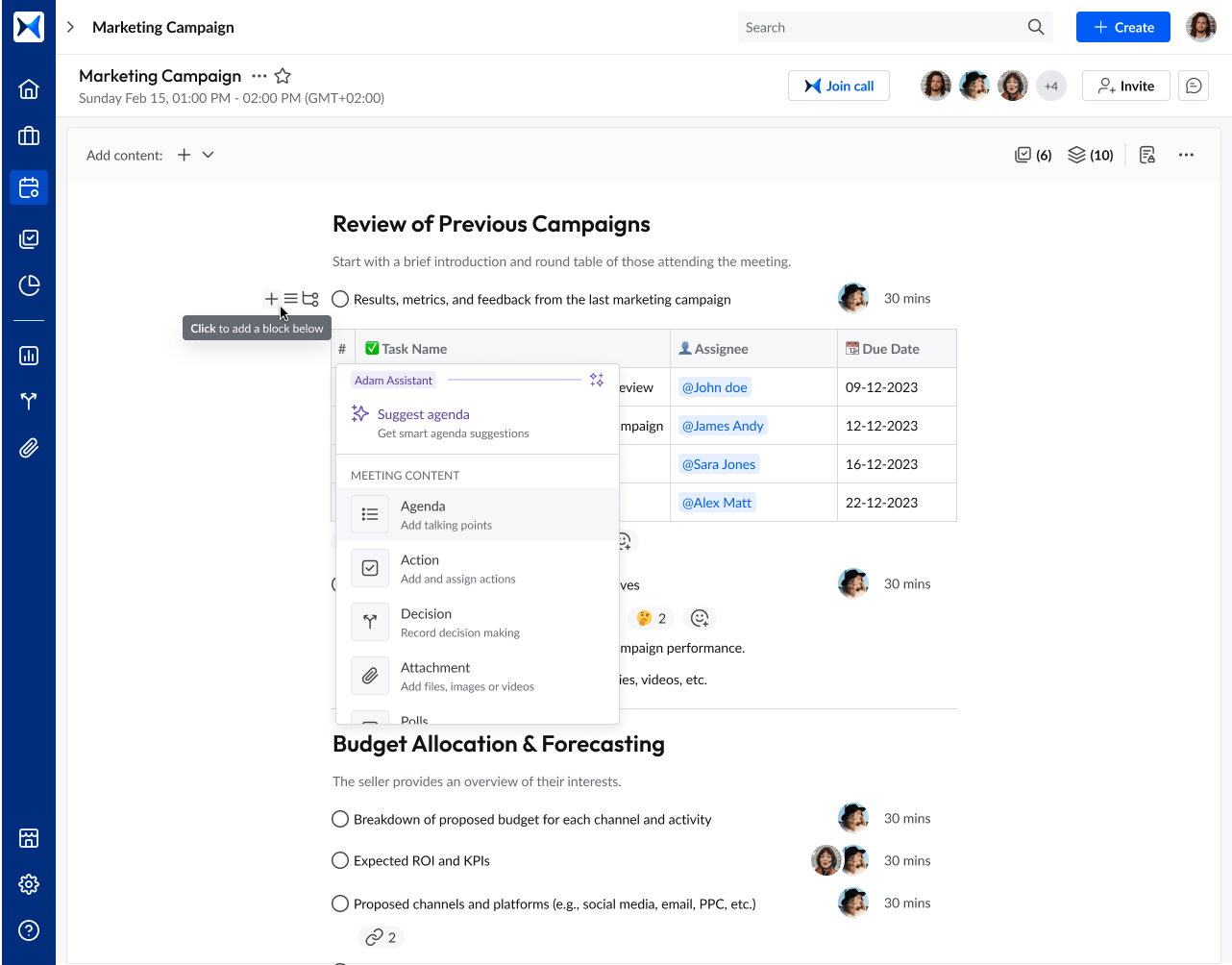
- Content collaboration: Share and review documents securely before meetings. This enables board members to come prepared, saving time for strategic discussions.
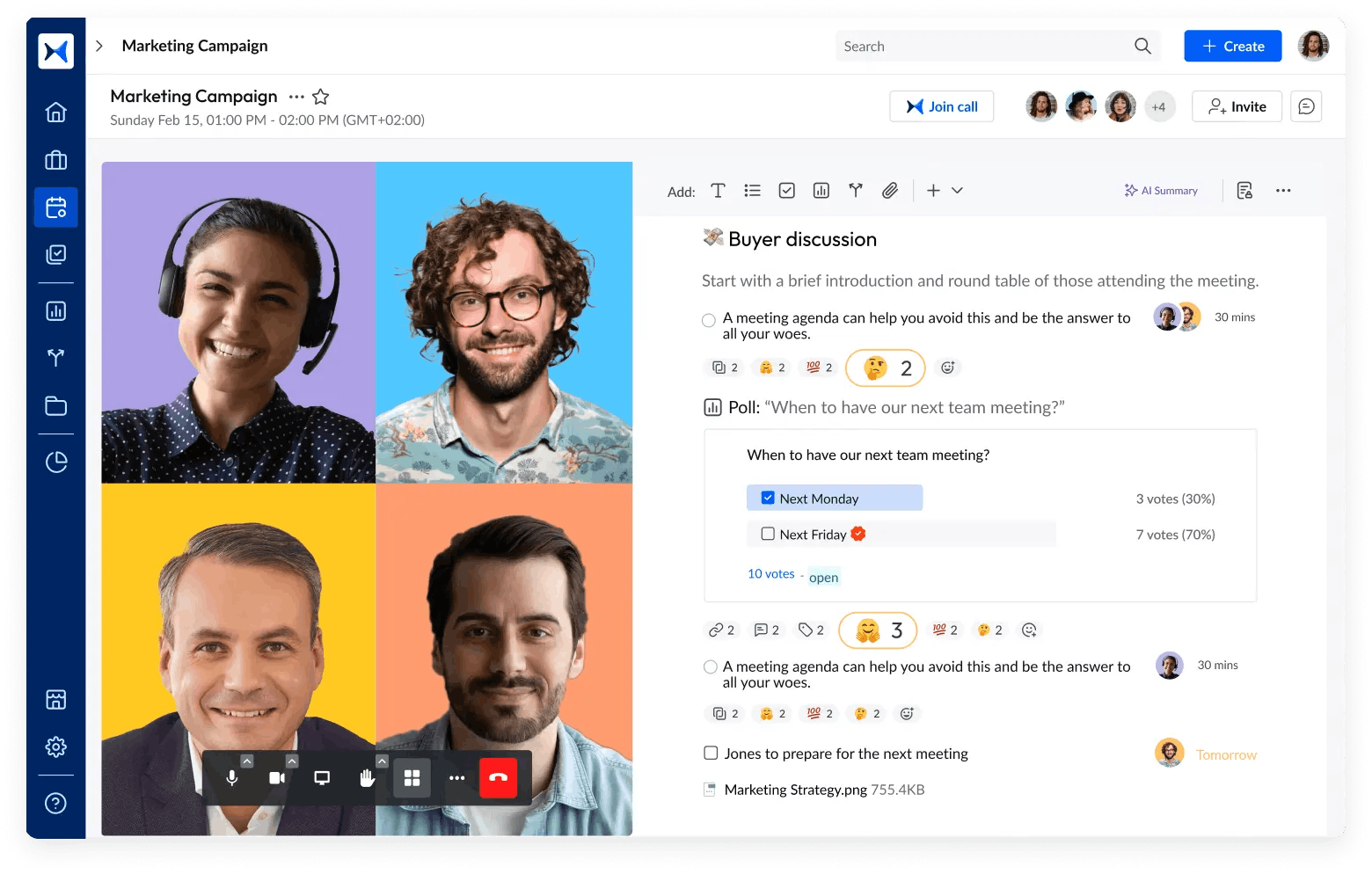
- Action tracking: Assign tasks with deadlines and monitor progress easily. This ensures decisions made during meetings lead to actionable outcomes and measurable impact.
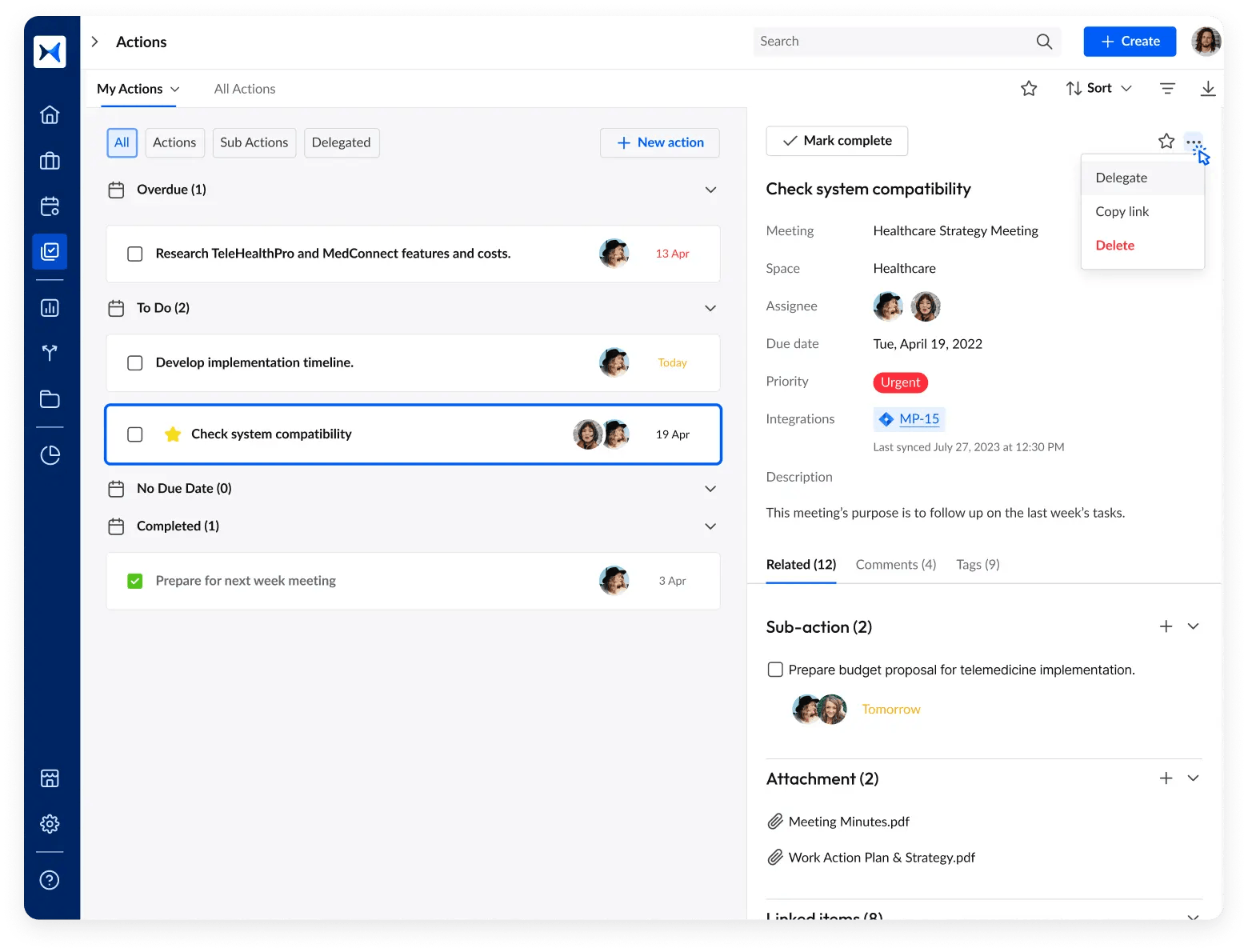
- Meeting minutes automation: Automatically capture accurate minutes, decisions, and action items. This reduces administrative work and ensures comprehensive records for compliance and transparency.
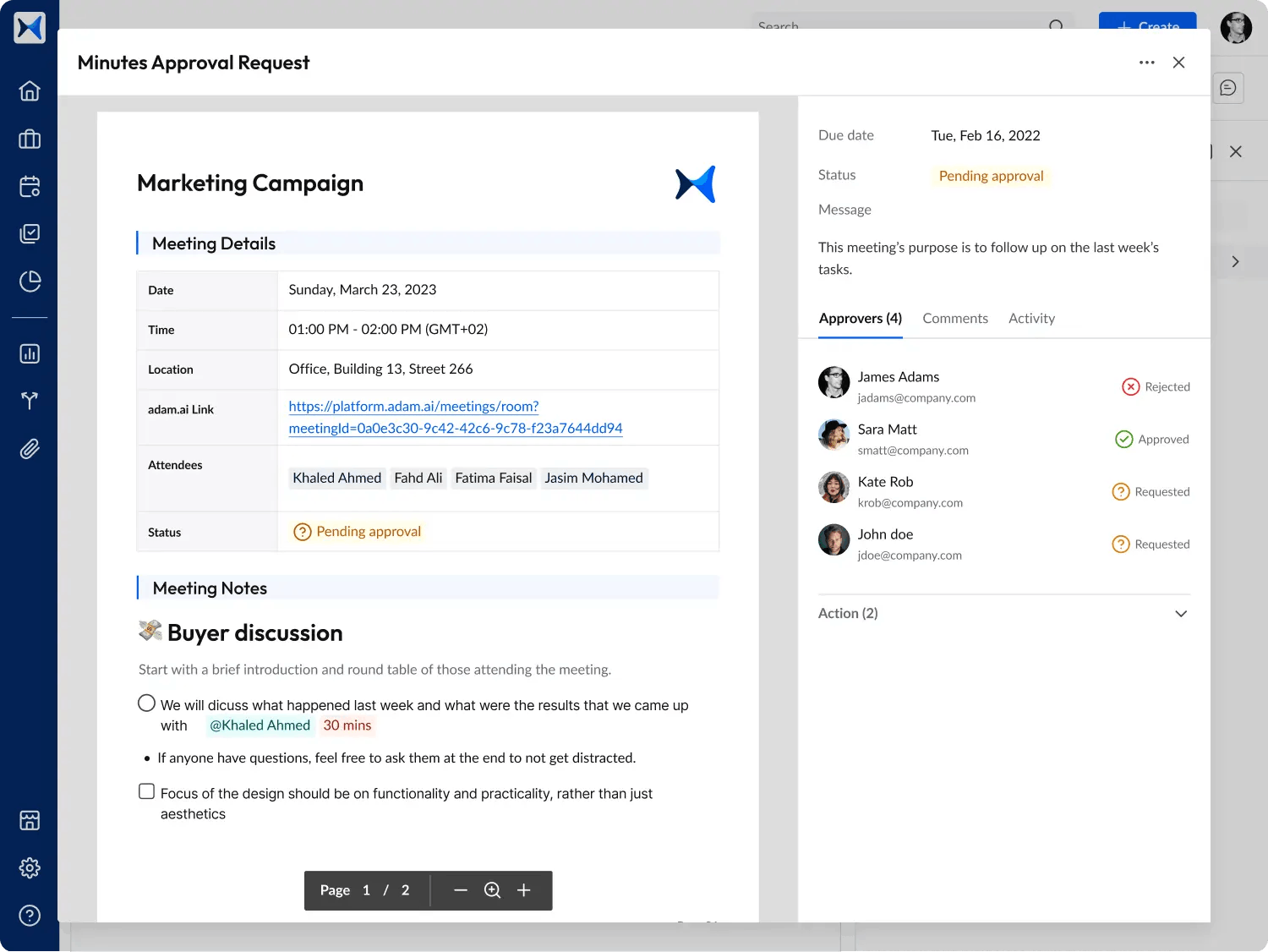
- Multi-space management: Organize meetings by project, program, or committee, helping non-profits manage diverse initiatives efficiently and keep relevant materials centralized.
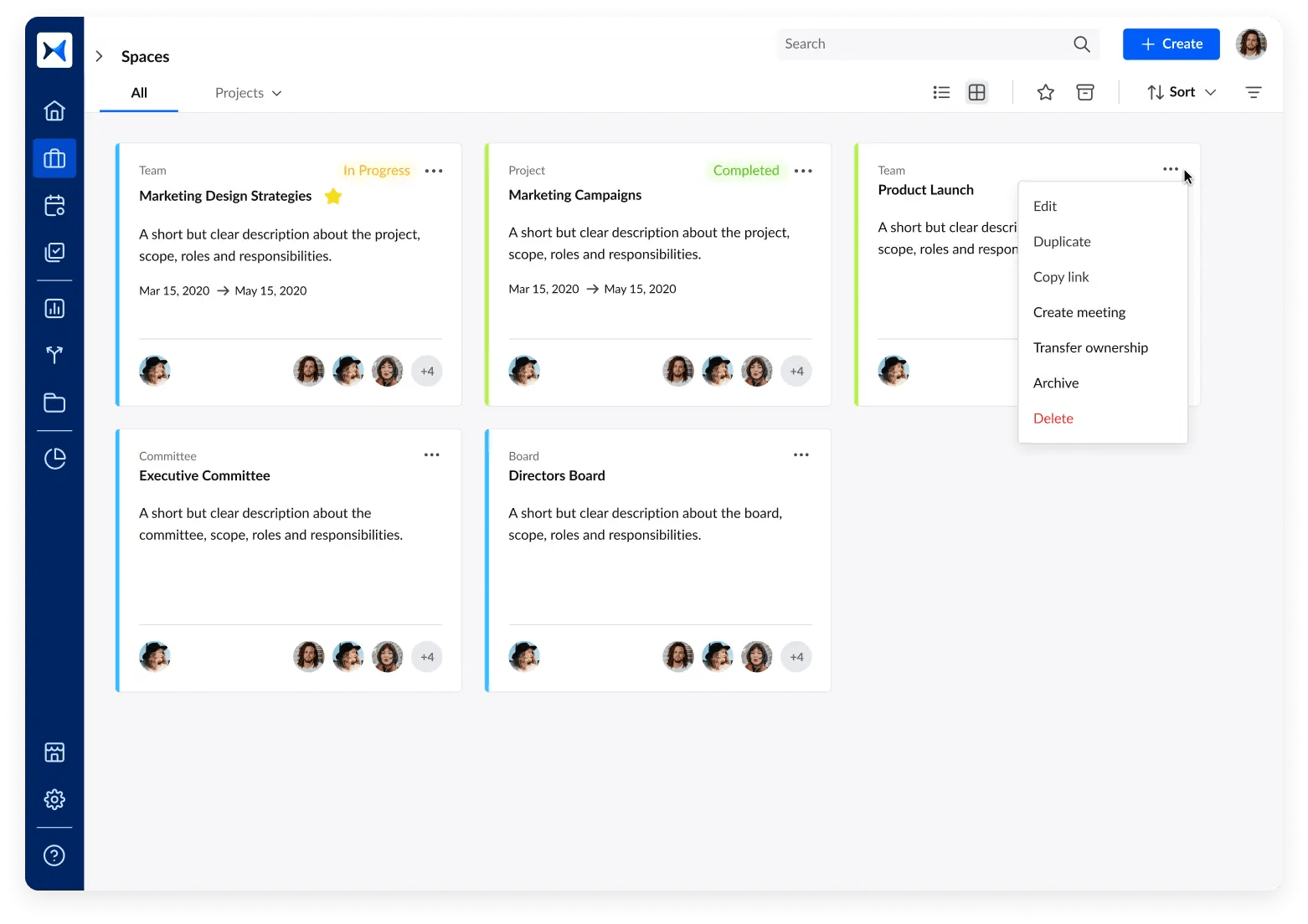
- Polling and voting tools: Simplify decision-making by conducting real-time polls or votes during meetings. This ensures inclusive participation and helps non-profits make faster, data-driven decisions.
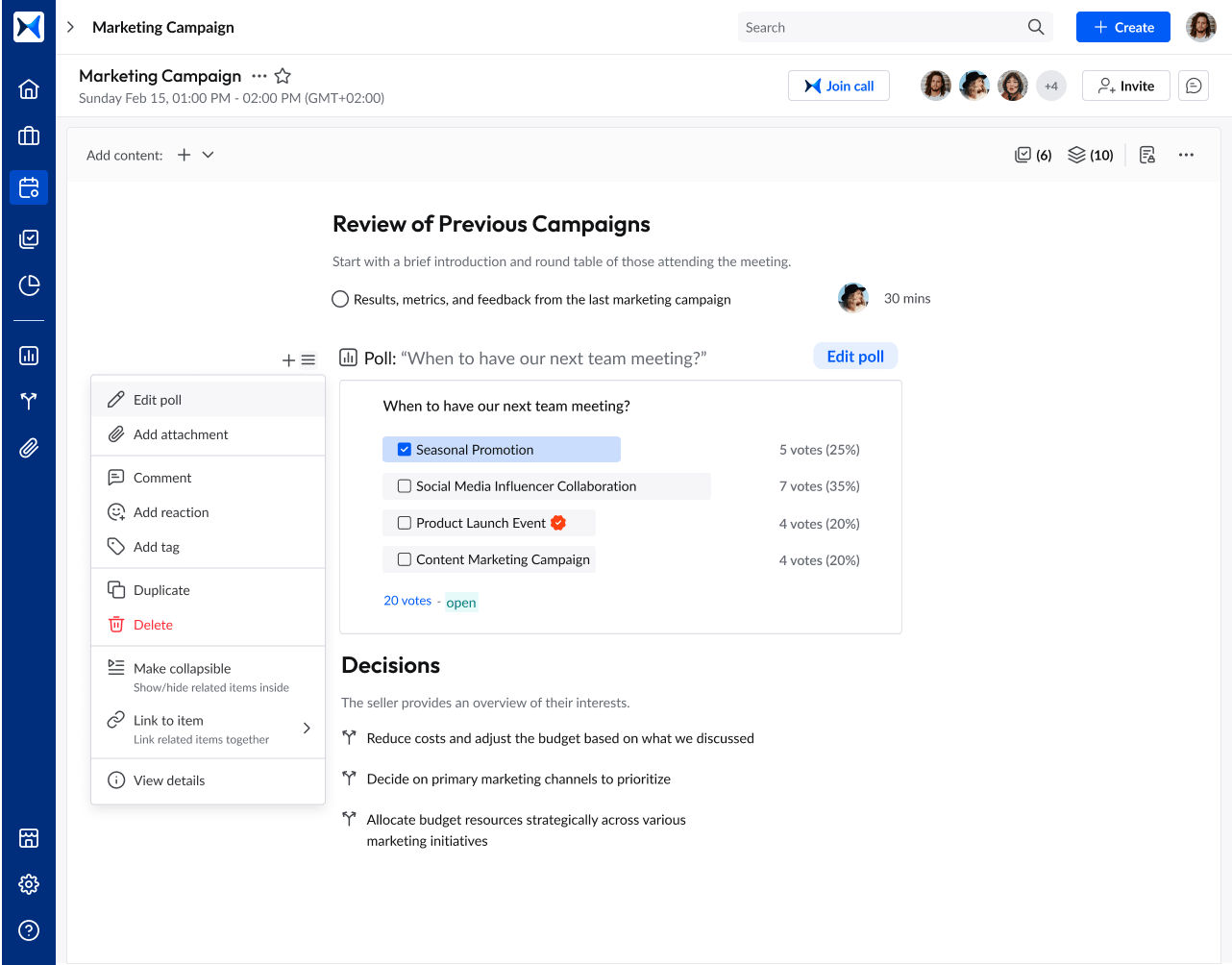
- Analytical dashboards: Gain insights into task completion, meeting outcomes, and board performance. Non-profits can use this data to evaluate progress and make informed decisions.
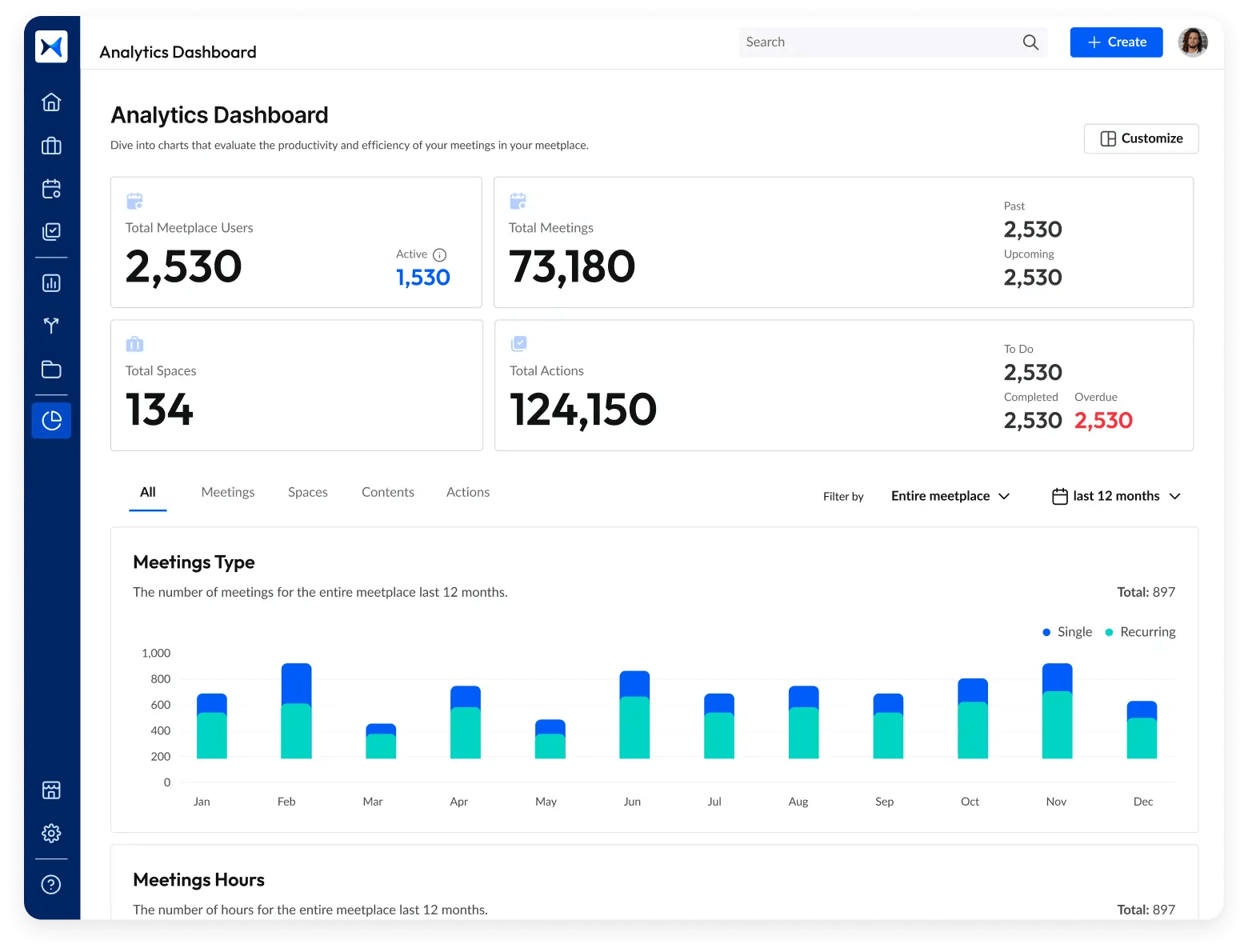
Transform how you conduct critical meetings—From meticulous preparation to effective execution and insightful follow-up, adam.ai integrates comprehensive analytics, full customization, and intuitive interfaces with powerful meeting management tools.
Easy onboarding. Enterprise-grade security. 24/7 dedicated support.
The bottom line
Streamlining board meetings is key to enhancing non-profit governance and achieving mission-driven goals. Modern tools offer innovative solutions to simplify these processes, making meetings more efficient and productive.
And while there may be multiple solutions available, here is why adam.ai is the meeting management software platform you can trust:
- adam.ai is one of Atlassian Ventures' portfolio companies.
- In the meeting management software category on G2, adam.ai has been ranked a leader and a high performer for successive quarters in the past years.
- adam.ai has been included in the Forrester Report in the AI-enabled meeting technology landscape.
- adam.ai is trusted and used by powerful teams and organizations worldwide for all types of critical meetings, like board, committee, project management, and business development meetings.
- And most importantly, adam.ai integrates with your existing workflow, is SOC2 compliant, provides dedicated support and success, and has a free trial option.
Subscribe to adam.ai blog
Stay ahead with the latest insights—get our newest blog posts, tips, and updates sent straight to your inbox.